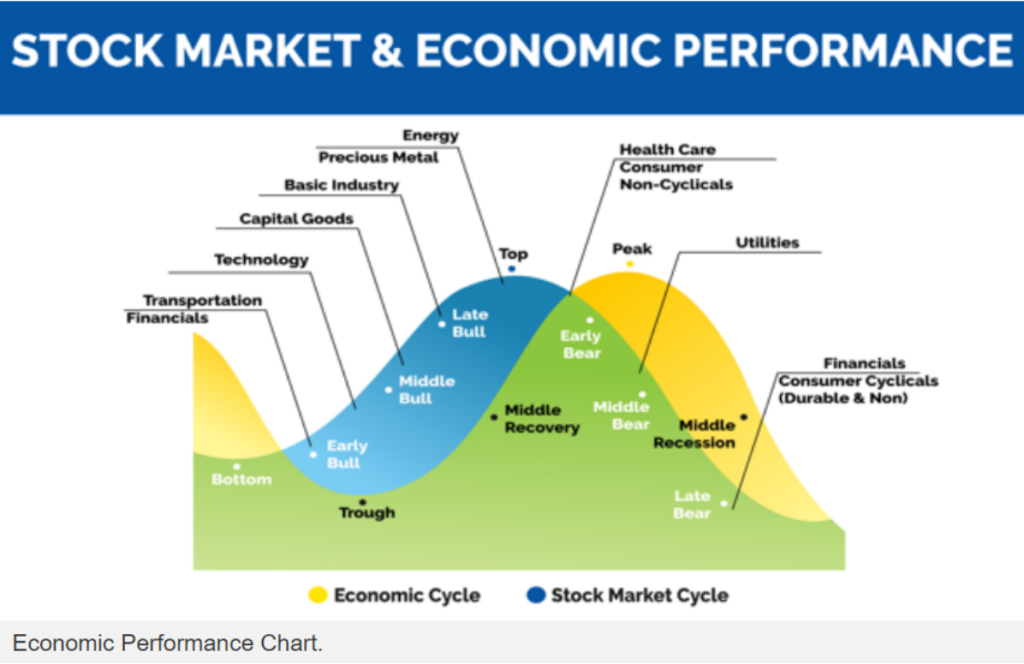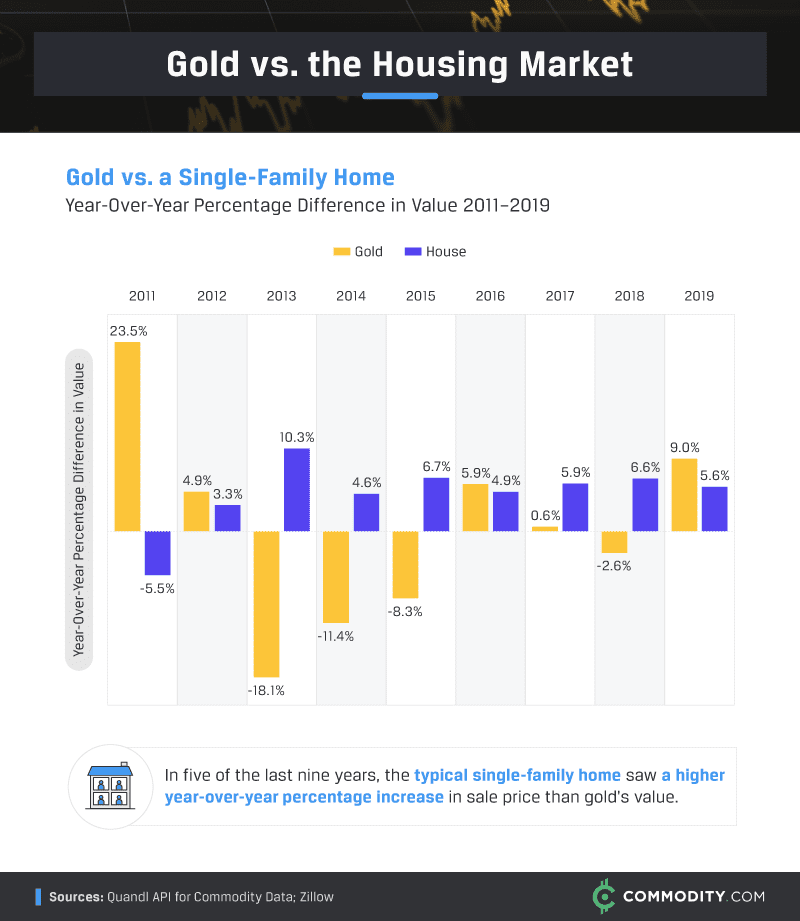محليًا: مقدمة عن دورات الأعمال وفئات الأصول
أهداف تعلم الدرس:
- Understand the business cycle: Recognize the phases of expansion, peak, contraction, and recession, and how they influence investment decisions.
- Identify different asset classes: تعلم حول stocks, bonds, real estate، و السلع, and their performance across business cycle stages.
- Apply diversification strategies: Grasp the importance of diversifying investments across different asset classes to mitigate risks and enhance portfolio resilience.
- Interpret sector performance: Analyze how different sectors like technology, real estate، و financials perform during various phases of the business cycle.
- Utilize economic indicators: Utilize figures and data to understand sector behavior and economic indicators over decades, aiding in strategic investment planning.
6.5.1 Introduction to Business Cycles and Asset Classes
ال دورة الأعمال التجارية in Europe, like elsewhere, goes through phases of expansion, peak, contraction، و recession. Different asset classes—مخازن, سندات, العقارات، و السلع—perform differently across these stages, driven by factors such as سياسات البنك المركزي الأوروبي, اسعار الفائدة، و النمو الاقتصادي. Understanding these phases is crucial for European investors who want to optimize their portfolios based on where the economy is in the cycle.
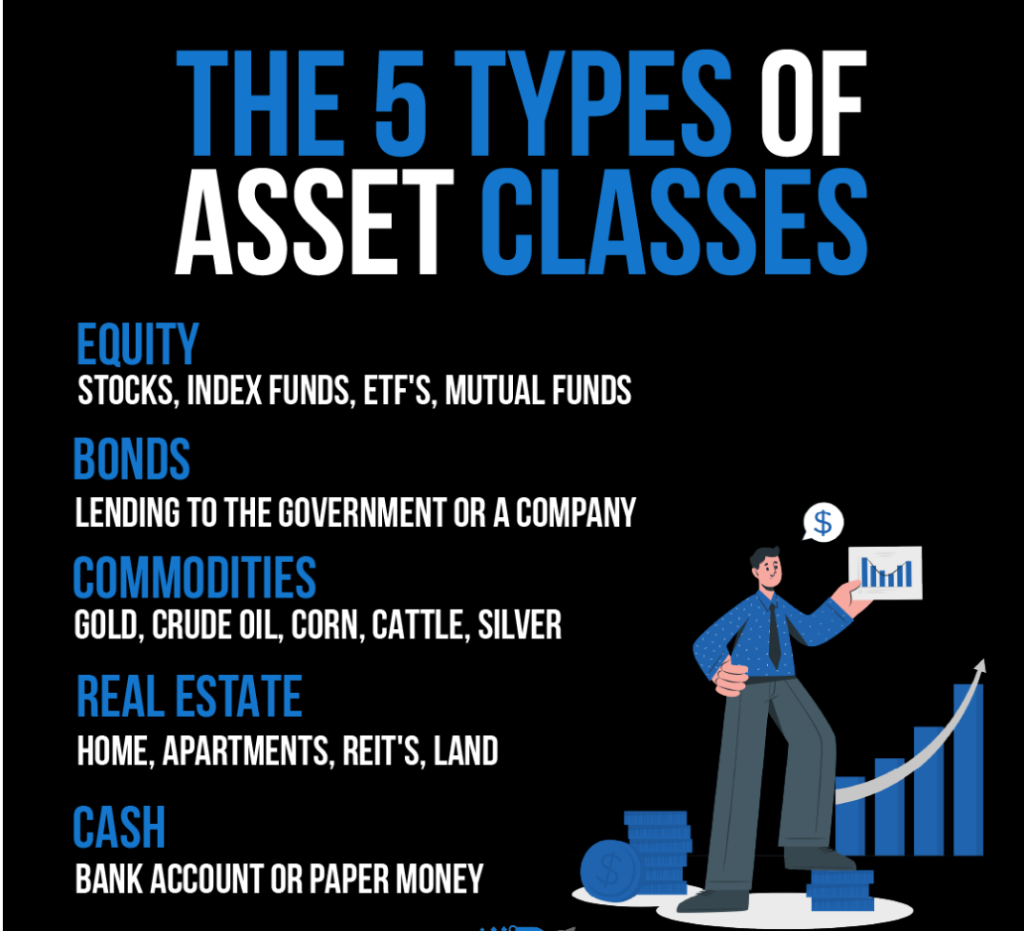
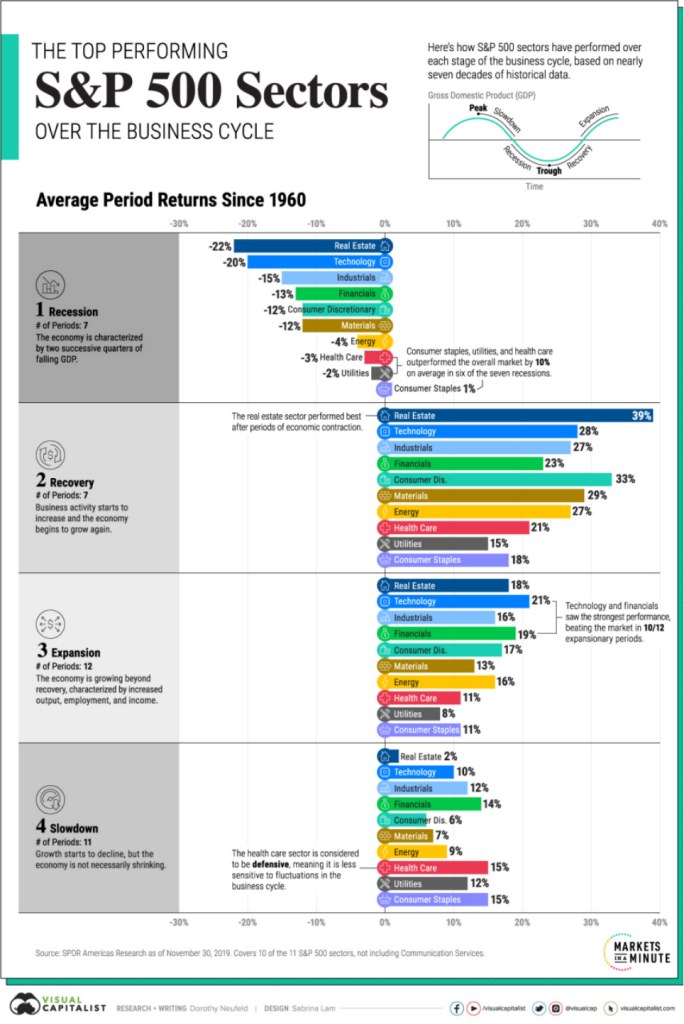
شكل: أداء قطاعات مؤشر S&P 500 خلال دورة الأعمال
وصف:
The figure shows the average period returns of S&P 500 sectors over different phases of the business cycle since 1960, including ركود, استعادة, توسع، و Slowdown. Each phase highlights how sectors perform during distinct economic conditions. For example, العقارات performs best during recovery, ، بينما تكنولوجيا و المالية excel during expansion. The figure provides insights into sector behavior across seven decades, helping users understand which sectors may outperform in specific economic phases.
الماخذ الرئيسية:
- العقارات generally outperforms during recovery, with an average return of 39%.
- تكنولوجيا و المالية lead during expansion, with returns of 28% and 23%, respectively.
- During slowdowns, الرعاىة الصحية is considered a defensive sector, offering more stable returns.
- السلع الاستهلاكية, خدمات، و الرعاىة الصحية outperform during recessions, being less sensitive to economic downturns.
تطبيق المعلومات:
Investors can use this data to optimize portfolio allocations based on expected economic phases. By identifying which sectors perform best during specific economic cycles, investors can strategically adjust their sector exposure to enhance returns and manage risks. Understanding sector performance across cycles can also help with تنويع and improve decision-making during market volatility.
6.5.2 Stocks, Bonds, and Cash: A Primer
- مخازن: European stocks tend to perform well during periods of expansion when corporate earnings are rising. Sectors such as السيارات, المستحضرات الصيدلانية، و financial services benefit most from GDP growth and increased consumer spending.
- سندات: European bonds, particularly sovereign bonds يحب German Bunds, are viewed as safe investments, especially during the contraction phase when interest rates are low. Corporate bonds from large European companies also perform well in early expansion phases.
- نقدي: Cash and equivalents, such as short-term government bonds أو money market funds, are typically favored in recessionary periods as they provide liquidity and protection against volatility.
Figure: Stock Market & Economic Performance
وصف:
The figure illustrates the relationship between the economic cycle و ال stock market cycle. It depicts the different stages of each cycle, including phases like Early Bull, Middle Bull, Late Bull, Early Bear، و Middle Recession. Key sectors such as طاقة, خدمات، و الرعاىة الصحية are aligned with specific phases, indicating their performance during economic transitions.
الماخذ الرئيسية:
- ال economic cycle و stock market cycle have distinct but interconnected phases.
- قطاعات مثل مواصلات و المالية perform well in the early bull phase, while خدمات excel at the peak.
- Basic industries و capital goods perform better in the middle bull phase, aligning with economic recovery.
- Precious metals و طاقة typically peak during the late bull phase.
- الرعاىة الصحية و Consumer Non-Cyclicals offer stability during recessions.
تطبيق المعلومات:
Understanding the correlation between the economic cycle و stock market performance can help investors make informed decisions about sector allocation based on economic phases. By aligning investments with phases like recovery أو recession, users can optimize returns and manage risk effectively. This approach aids in strategic portfolio diversification across economic conditions.
6.5.3 Early Expansion Phase
خلال early expansion phase in Europe, economic recovery begins with rising GDP, low interest rates, and growing investor confidence.
- مخازن: European stocks, particularly in sectors like consumer discretionary و تكنولوجيا, tend to perform well as the economy rebounds.
- سندات: High-yield corporate bonds are attractive as companies recover and their credit risk decreases.
- نقدي: Cash is less attractive during this phase as investors seek higher returns in riskier asset classes.
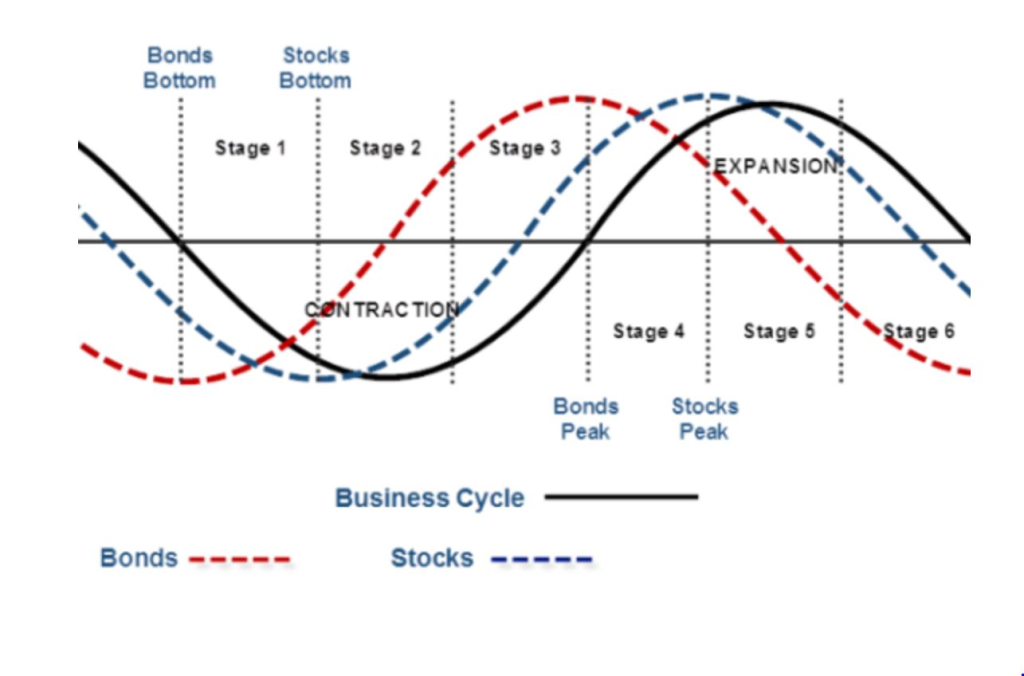
شكل: Business Cycle and Market Phases
وصف:
The figure shows the relationship between the business cycle and the performance of bonds and stocks over six distinct stages. It demonstrates that سندات tend to perform well during early stages of economic contraction, reaching their lowest point earlier than stocks. As the business cycle progresses towards economic expansion, stocks begin to recover and outperform bonds, peaking at later stages of the expansion.
الماخذ الرئيسية:
- سندات generally perform well during the early contraction phase of the business cycle, peaking sooner than stocks.
- مخازن tend to bottom out after bonds and excel during the later expansion phase.
- The cycle demonstrates distinct stages where different asset classes show stronger performance.
- Understanding the timing of bonds’ and stocks’ peaks and bottoms can be crucial for effective إدارة المحافظ.
تطبيق المعلومات:
Investors can use this information to align their استراتيجيات الاستثمار with the business cycle, focusing more on سندات during contraction and shifting towards مخازن as the economy expands. This helps optimize returns by timing asset allocation according to the specific phases of the business cycle.
6.5.4 Mid Expansion Phase
ال mid expansion phase in Europe brings stable growth and moderate inflation.
- مخازن: Sectors such as financial services و industrial goods perform strongly.
- سندات: Corporate bonds remain attractive, but rising interest rates make السندات الحكومية less appealing.
- نقدي: Cash is still not a favored option, though it may be used by investors seeking to hedge against future volatility.
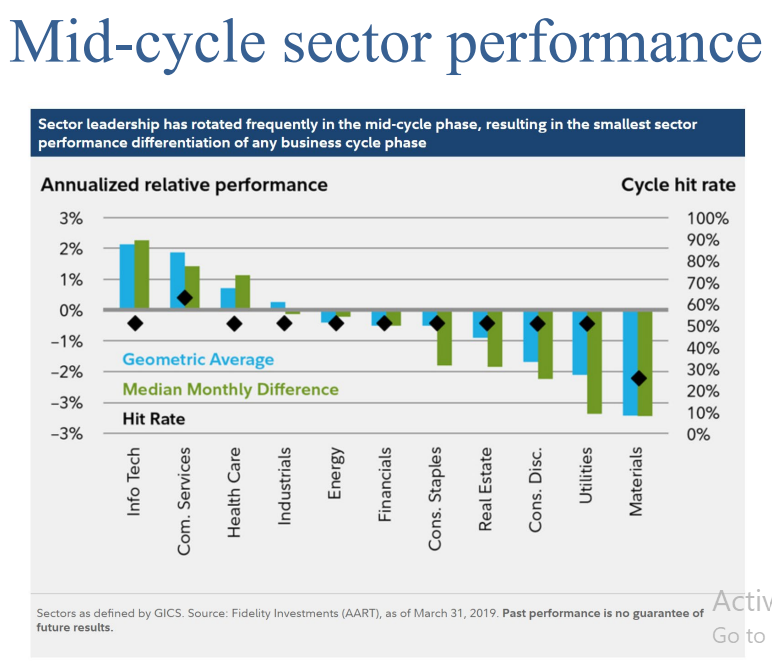
شكل:
وصف:
الماخذ الرئيسية:
تطبيق المعلومات:
6.5.5 Late Expansion Phase
في late expansion phase in Europe, the economy begins to overheat, with rising inflation and tightening labor markets.
- مخازن: Defensive sectors like المرافق و healthcare start to outperform.
- سندات: Government bonds become attractive again as investors seek safety amid rising interest rates.
- نقدي: Cash becomes a more attractive asset class as the economy nears a potential downturn.
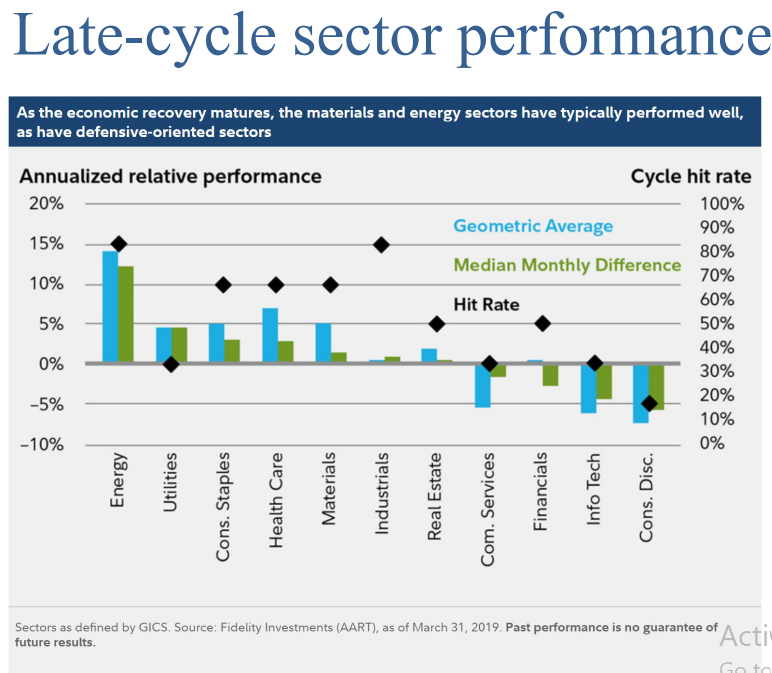
شكل:
وصف:
الماخذ الرئيسية:
تطبيق المعلومات:
6.5.6 Recession
During a recession in Europe, economic activity contracts, and unemployment rises.
- مخازن: European stocks typically suffer significant losses, with cyclical sectors such as السيارات و consumer discretionary being the hardest hit.
- سندات: Government bonds, especially from stable economies like Germany, outperform as investors seek safety.
- نقدي: Cash becomes the safest investment as market volatility increases.
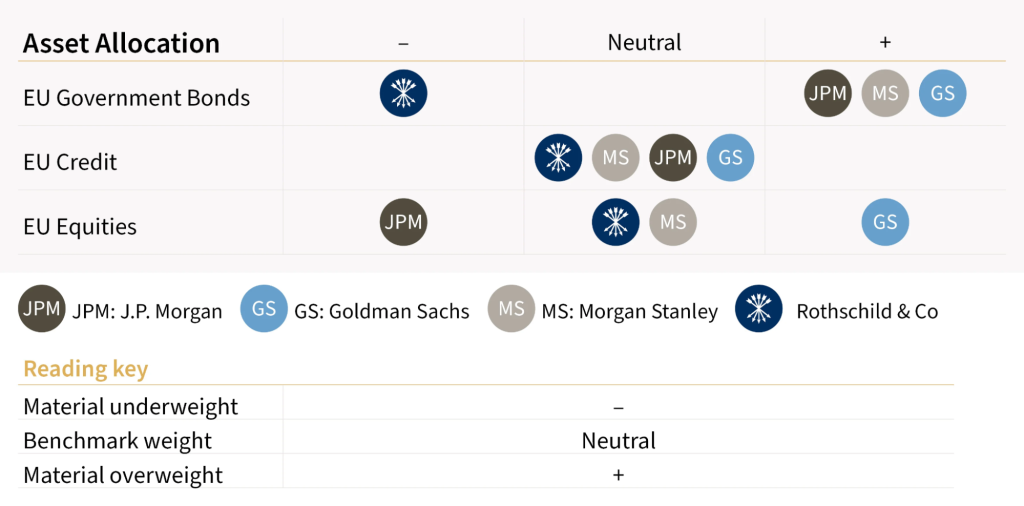
شكل: Asset Allocation by Major BanksAsset Allocation by Major Banks
وصف:
This figure presents the asset allocation preferences of four major banks—J.P. Morgan (JPM), Goldman Sachs (GS), Morgan Stanley (MS)، و Rothschild & Co.—across three categories: EU Government Bonds, EU Credit، و EU Equities. The positions are classified as material underweight (-), benchmark weight (neutral), ، أو material overweight (+), indicating each bank’s level of exposure or preference for these assets.
الماخذ الرئيسية:
- J.P. Morgan is materially overweight on EU Equities while being neutral on EU Government Bonds و EU Credit.
- Goldman Sachs shows a more balanced approach, favoring EU Credit و EU Equities as overweight positions while remaining neutral on EU Government Bonds.
- Morgan Stanley maintains a neutral position on EU Government Bonds و EU Credit, with a slight overweight in EU Equities.
- Rothschild & Co. adopts a material underweight stance in EU Government Bonds but a neutral stance on both EU Credit و EU Equities.
تطبيق المعلومات:
Investors can use this information to understand the asset allocation preferences of major banks, which can guide their own استراتيجيات الاستثمار. By observing how financial institutions position themselves in different asset classes, investors can make informed decisions about تنويع المحفظة والإمكانات market opportunities.
6.5.7 Real Estate and Commodities: An Overview
- العقارات: Real estate in Europe is influenced by local economic conditions, particularly interest rates and consumer demand. During expansion phases, commercial و residential real estate tends to perform well, while in recessions, property values may decline.
- السلع: Commodities like oil و natural gas are key to Europe’s energy sector. Rising أسعار السلع الأساسية benefit energy-exporting countries during the late expansion phase, while gold performs well during recessions as a safe-haven asset.
شكل: Gold vs. a Single-Family Home
وصف:
The figure compares the year-over-year percentage difference in value بين gold و single-family homes from 2011 to 2019. It shows annual changes for each asset, with gold depicted in yellow and housing in blue. For five out of these nine years, single-family homes exhibited a higher percentage increase in value than gold. Notable differences include 2011, where gold increased significantly by 23.5%, and 2013, where it dropped by -18.1%.
الماخذ الرئيسية:
- Gold had a significant spike in 2011, while housing showed more stable growth over the period.
- منازل لأسرة واحدة outperformed gold in terms of annual percentage increase for five of the nine years.
- In 2013, gold experienced its largest decline, contrasting with a modest increase in housing.
- ال housing market showed consistent growth from 2012 to 2019, suggesting more stable returns compared to gold.
تطبيق المعلومات:
Investors can use this comparison to understand the relative stability of the housing market compared to gold, which can be more volatile. This data helps in deciding asset allocation, suggesting that العقارات may offer more consistent returns over time, while gold can act as a hedge during economic downturns.
6.5.8 Real Estate Across Business Cycle Stages
- التوسع المبكر: Real estate begins to recover, with increased demand for housing and commercial properties.
- منتصف التوسع: Real estate thrives, with strong growth in both residential and commercial sectors.
- التوسع المتأخر: Rising interest rates slow real estate growth, particularly in over-leveraged markets.
- ركود: Real estate values typically decline due to reduced demand and tighter credit conditions.
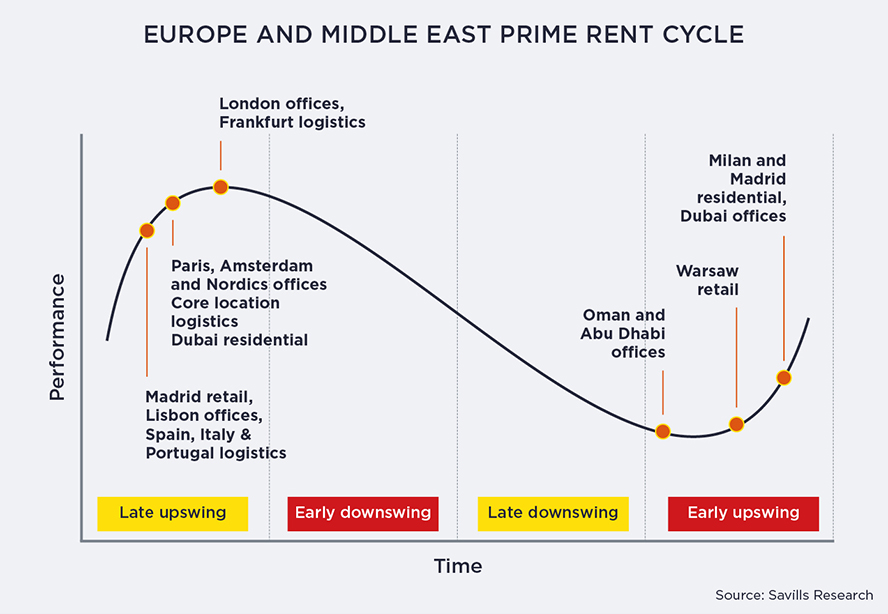
شكل: Europe and Middle East Prime Rent Cycle
وصف:
The figure illustrates the prime rent cycle across various markets in Europe and the Middle East, highlighting different phases of performance over time. The cycle is divided into four stages: late upswing, early downswing, late downswing، و early upswing. It showcases how prime rents in cities like London, Frankfurt, Paris, Amsterdam, and Warsaw evolve through these stages, with certain markets peaking during the upswing and others declining during the downswing.
الماخذ الرئيسية:
- London offices و Frankfurt logistics are at the peak of the late upswing phase.
- باريس, أمستردام، و Dubai residential enter the early downswing phase, indicating declining prime rents.
- Madrid retail و Lisbon offices reach the late downswing phase, representing lower performance.
- Markets like Warsaw retail و Milan residential start to enter the early upswing, signaling potential recovery in prime rents.
تطبيق المعلومات:
فهم prime rent cycle أمر بالغ الأهمية ل مستثمري العقارات, as it helps identify the best entry and exit points in different markets. This knowledge can guide investment strategies, highlighting when to focus on growth markets during the early upswing or consider divestment during the downswing phases.
6.5.9 Commodities Across Business Cycle Stages
- التوسع المبكر: Commodities like industrial metals recover as production ramps up.
- منتصف التوسع: Commodities, particularly طاقة و زراعة, perform well as consumption increases.
- التوسع المتأخر: Gold becomes attractive as an inflation hedge.
- ركود: Commodities like oil decline due to reduced demand, but gold performs well as a safe-haven asset.
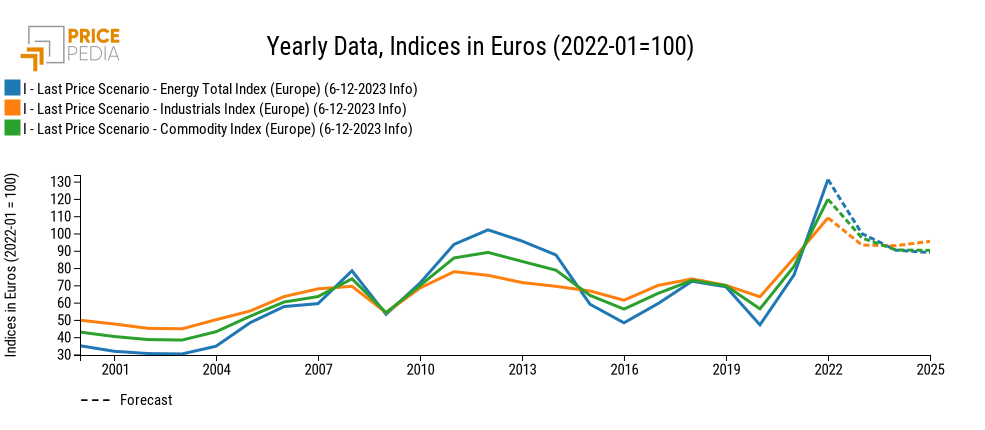
شكل: Yearly Data, Indices in Euros (2022-01=100)
وصف:
The figure displays the yearly trends of three indices in Europe from 2000 to 2025, including the Energy Total Index, Industrials Index، و Commodity Index. Each index starts from a base value of 100 in January 2022, reflecting how the indices have fluctuated over time. The forecast section, represented by dashed lines, shows the projected movement of these indices up to 2025.
الماخذ الرئيسية:
- ال Energy Total Index has shown the highest volatility over time compared to the other indices.
- There was a noticeable dip across all indices around 2009, coinciding with the global financial crisis.
- The forecast indicates a gradual decline in all three indices, reflecting an anticipated economic slowdown in 2024 and 2025.
- ال Industrials Index remains relatively stable compared to energy and commodity indices over the observed period.
تطبيق المعلومات:
This data helps investors understand the historical and projected price trends in energy, industrials, and commodities sectors in Europe. Investors can use this information to adjust their استراتيجيات الاستثمار, anticipate potential risks, and make informed decisions regarding sector-specific allocations, especially considering projected declines.
معلومات الدرس الرئيسية:
- Business cycles dictate asset performance: Asset classes such as real estate, technology، و financials have distinct performances tied to economic phases like recovery و expansion.
- Diversification is key: By diversifying across asset classes, investors can reduce risks and take advantage of growth opportunities in different economic conditions.
- Sector-specific insights are valuable: Understanding which sectors التفوق during specific business cycle phases can lead to more informed investment strategies.
- Economic indicators are essential tools: Utilizing economic indicators and sector performance data helps in anticipating market conditions and aligning investments accordingly.
- Strategic planning enhances returns: Aligning investment strategies with the دورة الأعمال التجارية phases facilitates better إدارة المخاطر and potential for higher returns.
كلمة الختام
Mastering the dynamics of the business cycle and its impact on different asset classes equips investors with the knowledge to make informed, strategic decisions that optimize returns and manage risks effectively.

